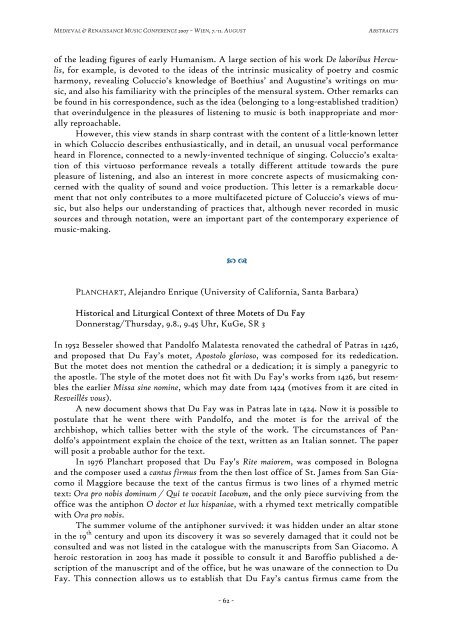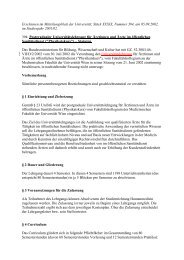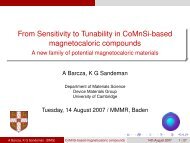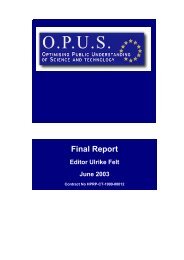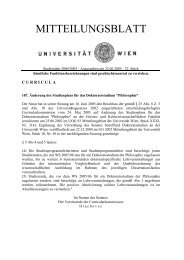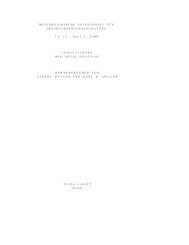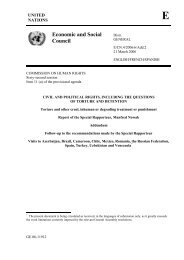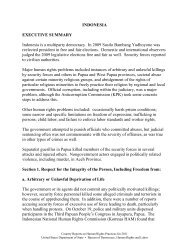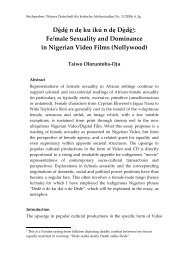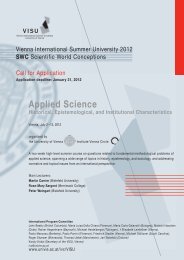(Stand: 25. Juli 2007) ANDERSON, Michael Alan ... - Universität Wien
(Stand: 25. Juli 2007) ANDERSON, Michael Alan ... - Universität Wien
(Stand: 25. Juli 2007) ANDERSON, Michael Alan ... - Universität Wien
Create successful ePaper yourself
Turn your PDF publications into a flip-book with our unique Google optimized e-Paper software.
MEDIEVAL & RENAISSANCE MUSIC CONFERENCE <strong>2007</strong> – WIEN, 7.-11. AUGUST ABSTRACTS<br />
of the leading figures of early Humanism. A large section of his work De laboribus Herculis,<br />
for example, is devoted to the ideas of the intrinsic musicality of poetry and cosmic<br />
harmony, revealing Coluccio’s knowledge of Boethius’ and Augustine’s writings on music,<br />
and also his familiarity with the principles of the mensural system. Other remarks can<br />
be found in his correspondence, such as the idea (belonging to a long-established tradition)<br />
that overindulgence in the pleasures of listening to music is both inappropriate and morally<br />
reproachable.<br />
However, this view stands in sharp contrast with the content of a little-known letter<br />
in which Coluccio describes enthusiastically, and in detail, an unusual vocal performance<br />
heard in Florence, connected to a newly-invented technique of singing. Coluccio’s exaltation<br />
of this virtuoso performance reveals a totally different attitude towards the pure<br />
pleasure of listening, and also an interest in more concrete aspects of musicmaking concerned<br />
with the quality of sound and voice production. This letter is a remarkable document<br />
that not only contributes to a more multifaceted picture of Coluccio’s views of music,<br />
but also helps our understanding of practices that, although never recorded in music<br />
sources and through notation, were an important part of the contemporary experience of<br />
music-making.<br />
� �<br />
PLANCHART, Alejandro Enrique (University of California, Santa Barbara)<br />
Historical and Liturgical Context of three Motets of Du Fay<br />
Donnerstag/Thursday, 9.8., 9.45 Uhr, KuGe, SR 3<br />
In 1952 Besseler showed that Pandolfo Malatesta renovated the cathedral of Patras in 1426,<br />
and proposed that Du Fay’s motet, Apostolo glorioso, was composed for its rededication.<br />
But the motet does not mention the cathedral or a dedication; it is simply a panegyric to<br />
the apostle. The style of the motet does not fit with Du Fay’s works from 1426, but resembles<br />
the earlier Missa sine nomine, which may date from 1424 (motives from it are cited in<br />
Resveillés vous).<br />
A new document shows that Du Fay was in Patras late in 1424. Now it is possible to<br />
postulate that he went there with Pandolfo, and the motet is for the arrival of the<br />
archbishop, which tallies better with the style of the work. The circumstances of Pandolfo’s<br />
appointment explain the choice of the text, written as an Italian sonnet. The paper<br />
will posit a probable author for the text.<br />
In 1976 Planchart proposed that Du Fay’s Rite maiorem, was composed in Bologna<br />
and the composer used a cantus firmus from the then lost office of St. James from San Giacomo<br />
il Maggiore because the text of the cantus firmus is two lines of a rhymed metric<br />
text: Ora pro nobis dominum / Qui te vocavit Iacobum, and the only piece surviving from the<br />
office was the antiphon O doctor et lux hispaniae, with a rhymed text metrically compatible<br />
with Ora pro nobis.<br />
The summer volume of the antiphoner survived: it was hidden under an altar stone<br />
in the 19 th century and upon its discovery it was so severely damaged that it could not be<br />
consulted and was not listed in the catalogue with the manuscripts from San Giacomo. A<br />
heroic restoration in 2003 has made it possible to consult it and Baroffio published a description<br />
of the manuscript and of the office, but he was unaware of the connection to Du<br />
Fay. This connection allows us to establish that Du Fay’s cantus firmus came from the<br />
- 62 -


